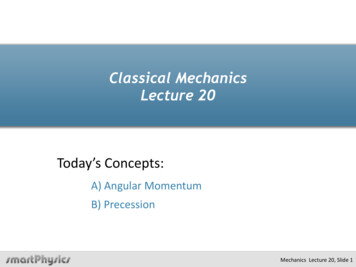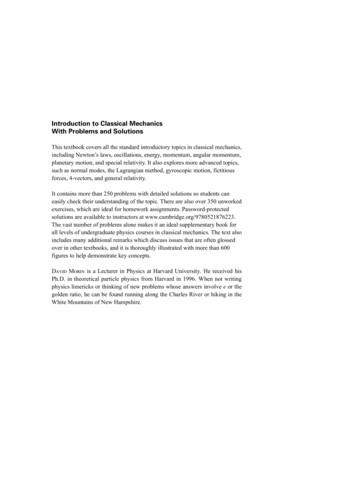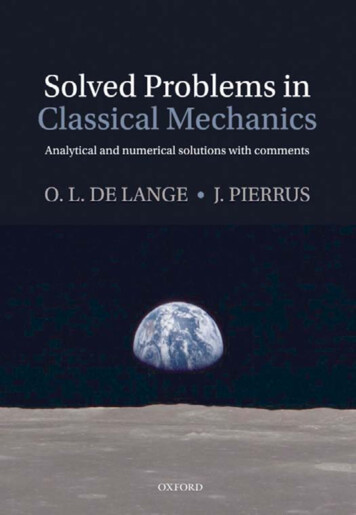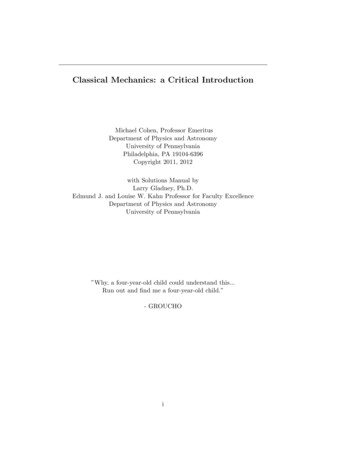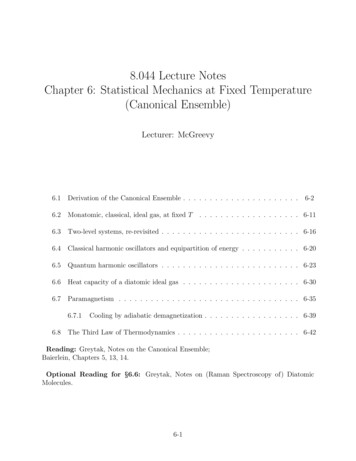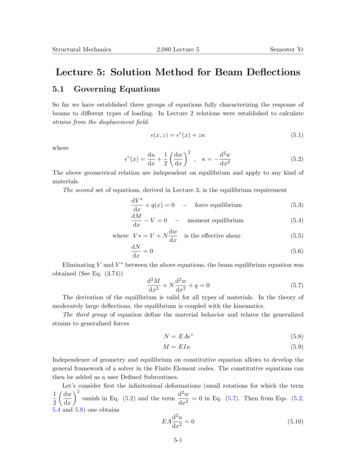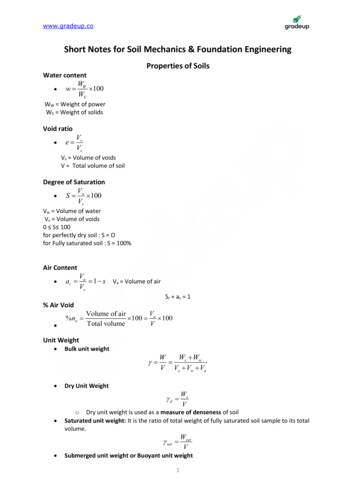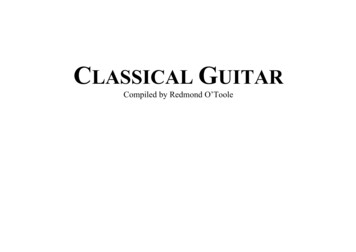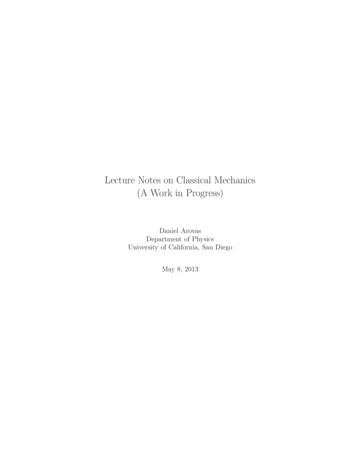
Transcription
Lecture Notes on Classical Mechanics(A Work in Progress)Daniel ArovasDepartment of PhysicsUniversity of California, San DiegoMay 8, 2013
Contents0.1Preface . . . . . . . . . . . . . . . . . . . . . . . . . . . . . . . . . . . . . .0 Reference Materialsxiii10.1Lagrangian Mechanics (mostly) . . . . . . . . . . . . . . . . . . . . . . . . .10.2Hamiltonian Mechanics (mostly) . . . . . . . . . . . . . . . . . . . . . . . .10.3Mathematics . . . . . . . . . . . . . . . . . . . . . . . . . . . . . . . . . . .21 Introduction to Dynamics1.11.21.33Introduction and Review . . . . . . . . . . . . . . . . . . . . . . . . . . . .31.1.1Newton’s laws of motion . . . . . . . . . . . . . . . . . . . . . . . .41.1.2Aside : inertial vs. gravitational mass . . . . . . . . . . . . . . . . .5Examples of Motion in One Dimension. . . . . . . . . . . . . . . . . . . .61.2.1Uniform force . . . . . . . . . . . . . . . . . . . . . . . . . . . . . .61.2.2Uniform force with linear frictional damping . . . . . . . . . . . . .71.2.3Uniform force with quadratic frictional damping . . . . . . . . . . .81.2.4Crossed electric and magnetic fields . . . . . . . . . . . . . . . . . .9Pause for Reflection . . . . . . . . . . . . . . . . . . . . . . . . . . . . . . .102 Systems of Particles112.1Work-Energy Theorem. . . . . . . . . . . . . . . . . . . . . . . . . . . . .112.2Conservative and Nonconservative Forces . . . . . . . . . . . . . . . . . . .12Example : integrating F U . . . . . . . . . . . . . . . . . . .14Conservative Forces in Many Particle Systems . . . . . . . . . . . . . . . .152.2.12.3i
iiCONTENTS2.4Linear and Angular Momentum . . . . . . . . . . . . . . . . . . . . . . . .162.5Scaling of Solutions for Homogeneous Potentials . . . . . . . . . . . . . . .182.5.1Euler’s theorem for homogeneous functions . . . . . . . . . . . . . .182.5.2Scaled equations of motion . . . . . . . . . . . . . . . . . . . . . . .182.62.7Appendix I : Curvilinear Orthogonal Coordinates. . . . . . . . . . . . . .202.6.1Example : spherical coordinates . . . . . . . . . . . . . . . . . . . .212.6.2Vector calculus : grad, div, curl . . . . . . . . . . . . . . . . . . . .21Common curvilinear orthogonal systems . . . . . . . . . . . . . . . . . . . .232.7.1Rectangular coordinates . . . . . . . . . . . . . . . . . . . . . . . .232.7.2Cylindrical coordinates . . . . . . . . . . . . . . . . . . . . . . . . .232.7.3Spherical coordinates . . . . . . . . . . . . . . . . . . . . . . . . . .242.7.4Kinetic energy . . . . . . . . . . . . . . . . . . . . . . . . . . . . . .253 One-Dimensional Conservative Systems3.13.23.33.4Description as a Dynamical System . . . . . . . . . . . . . . . . . . . . . .273.1.1Example : harmonic oscillator . . . . . . . . . . . . . . . . . . . . .28One-Dimensional Mechanics as a Dynamical System . . . . . . . . . . . . .293.2.1Sketching phase curves . . . . . . . . . . . . . . . . . . . . . . . . .29Fixed Points and their Vicinity . . . . . . . . . . . . . . . . . . . . . . . . .313.3.1Linearized dynamics in the vicinity of a fixed point . . . . . . . . .31Examples of Conservative One-Dimensional Systems . . . . . . . . . . . . .333.4.1Harmonic oscillator . . . . . . . . . . . . . . . . . . . . . . . . . . .333.4.2Pendulum . . . . . . . . . . . . . . . . . . . . . . . . . . . . . . . .343.4.3Other potentials . . . . . . . . . . . . . . . . . . . . . . . . . . . . .364 Linear Oscillations4.12741Damped Harmonic Oscillator . . . . . . . . . . . . . . . . . . . . . . . . . .414.1.1Classes of damped harmonic motion . . . . . . . . . . . . . . . . . .424.1.2Remarks on the case of critical damping . . . . . . . . . . . . . . .44
CONTENTS4.1.3iiiPhase portraits for the damped harmonic oscillator . . . . . . . . .45Damped Harmonic Oscillator with Forcing . . . . . . . . . . . . . . . . . .464.2.1Resonant forcing . . . . . . . . . . . . . . . . . . . . . . . . . . . . .494.2.2R-L-C circuits . . . . . . . . . . . . . . . . . . . . . . . . . . . . . .504.2.3Examples . . . . . . . . . . . . . . . . . . . . . . . . . . . . . . . . .514.3General solution by Green’s function method . . . . . . . . . . . . . . . . .544.4General Linear Autonomous Inhomogeneous ODEs . . . . . . . . . . . . . .554.5Kramers-Krönig Relations (advanced material) . . . . . . . . . . . . . . . .594.25 Calculus of Variations615.1Snell’s Law . . . . . . . . . . . . . . . . . . . . . . . . . . . . . . . . . . . .615.2Functions and Functionals . . . . . . . . . . . . . . . . . . . . . . . . . . . .625.2.1Functional Taylor series . . . . . . . . . . . . . . . . . . . . . . . . .66Examples from the Calculus of Variations . . . . . . . . . . . . . . . . . . .665.3.1Example 1 : minimal surface of revolution . . . . . . . . . . . . . .665.3.2Example 2 : geodesic on a surface of revolution . . . . . . . . . . .685.3.3Example 3 : brachistochrone . . . . . . . . . . . . . . . . . . . . . .695.3.4Ocean waves . . . . . . . . . . . . . . . . . . . . . . . . . . . . . . .70Appendix : More on Functionals . . . . . . . . . . . . . . . . . . . . . . . .725.35.46 Lagrangian Mechanics796.1Generalized Coordinates . . . . . . . . . . . . . . . . . . . . . . . . . . . . .796.2Hamilton’s Principle . . . . . . . . . . . . . . . . . . . . . . . . . . . . . . .806.2.1Invariance of the equations of motion . . . . . . . . . . . . . . . . .806.2.2Remarks on the order of the equations of motion. . . . . . . . . .806.2.3Lagrangian for a free particle . . . . . . . . . . . . . . . . . . . . . .81Conserved Quantities . . . . . . . . . . . . . . . . . . . . . . . . . . . . . .826.3.1Momentum conservation . . . . . . . . . . . . . . . . . . . . . . . .826.3.2Energy conservation . . . . . . . . . . . . . . . . . . . . . . . . . . .836.3
ivCONTENTS6.4Choosing Generalized Coordinates . . . . . . . . . . . . . . . . . . . . . . .846.5How to Solve Mechanics Problems . . . . . . . . . . . . . . . . . . . . . . .856.6Examples . . . . . . . . . . . . . . . . . . . . . . . . . . . . . . . . . . . . .856.6.1One-dimensional motion . . . . . . . . . . . . . . . . . . . . . . . .856.6.2Central force in two dimensions . . . . . . . . . . . . . . . . . . . .866.6.3A sliding point mass on a sliding wedge . . . . . . . . . . . . . . . .866.6.4A pendulum attached to a mass on a spring . . . . . . . . . . . . .886.6.5The double pendulum . . . . . . . . . . . . . . . . . . . . . . . . . .906.6.6The thingy . . . . . . . . . . . . . . . . . . . . . . . . . . . . . . . .92Appendix : Virial Theorem . . . . . . . . . . . . . . . . . . . . . . . . . . .946.77 Noether’s Theorem7.197Continuous Symmetry Implies Conserved Charges . . . . . . . . . . . . . .977.1.1Examples of one-parameter families of transformations . . . . . . .987.2Conservation of Linear and Angular Momentum . . . . . . . . . . . . . . .997.3Advanced Discussion : Invariance of L vs. Invariance of S . . . . . . . . . .1007.3.1The Hamiltonian . . . . . . . . . . . . . . . . . . . . . . . . . . . .1017.3.2Is H T U ? . . . . . . . . . . . . . . . . . . . . . . . . . . . . .1037.3.3Example: A bead on a rotating hoop . . . . . . . . . . . . . . . . .1047.4Charged Particle in a Magnetic Field . . . . . . . . . . . . . . . . . . . . .1067.5Fast Perturbations : Rapidly Oscillating Fields . . . . . . . . . . . . . . . .1087.5.1Example : pendulum with oscillating support . . . . . . . . . . . .110Field Theory: Systems with Several Independent Variables . . . . . . . . .1117.6.11147.6Gross-Pitaevskii model . . . . . . . . . . . . . . . . . . . . . . . . .8 Constraints1178.1Constraints and Variational Calculus . . . . . . . . . . . . . . . . . . . . . .1178.2Constrained Extremization of Functions . . . . . . . . . . . . . . . . . . . .1198.3Extremization of Functionals : Integral Constraints . . . . . . . . . . . . .119
CONTENTS8.48.58.6vExtremization of Functionals : Holonomic Constraints . . . . . . . . . . . .1208.4.1Examples of extremization with constraints . . . . . . . . . . . . . .121Application to Mechanics . . . . . . . . . . . . . . . . . . . . . . . . . . . .1238.5.1Constraints and conservation laws . . . . . . . . . . . . . . . . . . .124Worked Examples . . . . . . . . . . . . . . . . . . . . . . . . . . . . . . . .1258.6.1One cylinder rolling off another . . . . . . . . . . . . . . . . . . . .1258.6.2Frictionless motion along a curve . . . . . . . . . . . . . . . . . . .1278.6.3Disk rolling down an inclined plane . . . . . . . . . . . . . . . . . .1308.6.4Pendulum with nonrigid support . . . . . . . . . . . . . . . . . . . .1318.6.5Falling ladder . . . . . . . . . . . . . . . . . . . . . . . . . . . . . .1338.6.6Point mass inside rolling hoop . . . . . . . . . . . . . . . . . . . . .1379 Central Forces and Orbital Mechanics9.1143Reduction to a one-body problem . . . . . . . . . . . . . . . . . . . . . . .1439.1.1Center-of-mass (CM) and relative coordinates . . . . . . . . . . . .1439.1.2Solution to the CM problem . . . . . . . . . . . . . . . . . . . . . .1449.1.3Solution to the relative coordinate problem . . . . . . . . . . . . . .1449.2Almost Circular Orbits . . . . . . . . . . . . . . . . . . . . . . . . . . . . .1479.3Precession in a Soluble Model . . . . . . . . . . . . . . . . . . . . . . . . . .1489.4The Kepler Problem: U (r) k r 1 . . . . . . . . . . . . . . . . . . . . . .1499.4.1Geometric shape of orbits . . . . . . . . . . . . . . . . . . . . . . .1499.4.2Laplace-Runge-Lenz vector . . . . . . . . . . . . . . . . . . . . . . .1509.4.3Kepler orbits are conic sections . . . . . . . . . . . . . . . . . . . .1529.4.4Period of bound Kepler orbits . . . . . . . . . . . . . . . . . . . . .1549.4.5Escape velocity . . . . . . . . . . . . . . . . . . . . . . . . . . . . .1559.4.6Satellites and spacecraft . . . . . . . . . . . . . . . . . . . . . . . .1569.4.7Two examples of orbital mechanics . . . . . . . . . . . . . . . . . .156Appendix I : Mission to Neptune . . . . . . . . . . . . . . . . . . . . . . . .1599.5.11629.5I. Earth to Jupiter. . . . . . . . . . . . . . . . . . . . . . . . . . .
viCONTENTS9.69.5.2II. Encounter with Jupiter . . . . . . . . . . . . . . . . . . . . . . .1639.5.3III. Jupiter to Neptune . . . . . . . . . . . . . . . . . . . . . . . . .165Appendix II : Restricted Three-Body Problem . . . . . . . . . . . . . . . .16610 Small Oscillations17310.1 Coupled Coordinates . . . . . . . . . . . . . . . . . . . . . . . . . . . . . . .17310.2 Expansion about Static Equilibrium . . . . . . . . . . . . . . . . . . . . . .17410.3 Method of Small Oscillations . . . . . . . . . . . . . . . . . . . . . . . . . .17410.3.1Can you really just choose an A so that both these wonderful thingshappen in 10.13 and 10.14? . . . . . . . . . . . . . . . . . . . . . . .17510.3.2Er.care to elaborate?. . . . . . . . . . . . . . . . . . . . . . . . .17510.3.3Finding the modal matrix . . . . . . . . . . . . . . . . . . . . . . .17610.4 Example: Masses and Springs . . . . . . . . . . . . . . . . . . . . . . . . . .17810.5 Example: Double Pendulum . . . . . . . . . . . . . . . . . . . . . . . . . .18010.6 Zero Modes . . . . . . . . . . . . . . . . . . . . . . . . . . . . . . . . . . . .18110.6.1Example of zero mode oscillations . . . . . . . . . . . . . . . . . . .18210.7 Chain of Mass Points . . . . . . . . . . . . . . . . . . . . . . . . . . . . . .18410.7.1Continuum limit . . . . . . . . . . . . . . . . . . . . . . . . . . . . .18710.8 Appendix I : General Formulation . . . . . . . . . . . . . . . . . . . . . . .18810.9 Appendix II : Additional Examples. . . . . . . . . . . . . . . . . . . . . .19010.9.1Right Triatomic Molecule . . . . . . . . . . . . . . . . . . . . . . . .19010.9.2Triple Pendulum . . . . . . . . . . . . . . . . . . . . . . . . . . . . .19210.9.3Equilateral Linear Triatomic Molecule. . . . . . . . . . . . . . . .19510.10 Aside : Christoffel Symbols . . . . . . . . . . . . . . . . . . . . . . . . . . .19911 Elastic Collisions20111.1 Center of Mass Frame . . . . . . . . . . . . . . . . . . . . . . . . . . . . . .20111.2 Central Force Scattering . . . . . . . . . . . . . . . . . . . . . . . . . . . . .20511.2.1Hard sphere scattering . . . . . . . . . . . . . . . . . . . . . . . . .20711.2.2Rutherford scattering . . . . . . . . . . . . . . . . . . . . . . . . . .208
CONTENTS11.2.3viiTransformation to laboratory coordinates . . . . . . . . . . . . . . .12 Noninertial Reference Frames20821112.1 Accelerated Coordinate Systems . . . . . . . . . . . . . . . . . . . . . . . .21112.1.1Translations . . . . . . . . . . . . . . . . . . . . . . . . . . . . . . .21312.1.2Motion on the surface of the earth . . . . . . . . . . . . . . . . . . .21312.2 Spherical Polar Coordinates . . . . . . . . . . . . . . . . . . . . . . . . . . .21412.3 Centrifugal Force . . . . . . . . . . . . . . . . . . . . . . . . . . . . . . . . .21612.3.1Rotating tube of fluid . . . . . . . . . . . . . . . . . . . . . . . . . .21612.4 The Coriolis Force . . . . . . . . . . . . . . . . . . . . . . . . . . . . . . . .21712.4.1Foucault’s pendulum . . . . . . . . . . . . . . . . . . . . . . . . . .13 Rigid Body Motion and Rotational Dynamics13.1 Rigid Bodies . . . . . . . . . . . . . . . . . . . . . . . . . . . . . . . . . . .13.1.1220223223Examples of rigid bodies . . . . . . . . . . . . . . . . . . . . . . . .22313.2 The Inertia Tensor . . . . . . . . . . . . . . . . . . . . . . . . . . . . . . . .22413.2.1Coordinate transformations. . . . . . . . . . . . . . . . . . . . . .22613.2.2The case of no fixed point . . . . . . . . . . . . . . . . . . . . . . .22613.3 Parallel Axis Theorem . . . . . . . . . . . . . . . . . . . . . . . . . . . . . .22713.3.1Example . . . . . . . . . . . . . . . . . . . . . . . . . . . . . . . . .22813.3.2General planar mass distribution . . . . . . . . . . . . . . . . . . .22913.4 Principal Axes of Inertia. . . . . . . . . . . . . . . . . . . . . . . . . . . .23013.5 Euler’s Equations . . . . . . . . . . . . . . . . . . . . . . . . . . . . . . . .23113.5.1Example . . . . . . . . . . . . . . . . . . . . . . . . . . . . . . . . .23413.6 Euler’s Angles . . . . . . . . . . . . . . . . . . . . . . . . . . . . . . . . . .23513.6.1Torque-free symmetric top . . . . . . . . . . . . . . . . . . . . . . .23713.6.2Symmetric top with one point fixed . . . . . . . . . . . . . . . . . .23813.7 Rolling and Skidding Motion of Real Tops . . . . . . . . . . . . . . . . . . .24113.7.1Rolling tops . . . . . . . . . . . . . . . . . . . . . . . . . . . . . . .241
viiiCONTENTS13.7.2Skidding tops . . . . . . . . . . . . . . . . . . . . . . . . . . . . . .24213.7.3Tippie-top . . . . . . . . . . . . . . . . . . . . . . . . . . . . . . . .24414 Continuum Mechanics24714.1 Strings . . . . . . . . . . . . . . . . . . . . . . . . . . . . . . . . . . . . . .24714.2 d’Alembert’s Solution to the Wave Equation . . . . . . . . . . . . . . . . .24914.2.1Energy density and energy current. . . . . . . . . . . . . . . . . .25014.2.2Reflection at an interface . . . . . . . . . . . . . . . . . . . . . . . .25114.2.3Mass point on a string . . . . . . . . . . . . . . . . . . . . . . . . .25214.2.4Interface between strings of different mass density . . . . . . . . . .25514.3 Finite Strings : Bernoulli’s Solution . . . . . . . . . . . . . . . . . . . . . .25714.4 Sturm-Liouville Theory . . . . . . . . . . . . . . . . . . . . . . . . . . . . .25914.4.1Variational method . . . . . . . . . . . . . . . . . . . . . . . . . . .26114.5 Continua in Higher Dimensions . . . . . . . . . . . . . . . . . . . . . . . . .26414.5.1Membranes . . . . . . . . . . . . . . . . . . . . . . . . . . . . . . . .26514.5.2Helmholtz equation . . . . . . . . . . . . . . . . . . . . . . . . . . .26614.5.3Rectangles . . . . . . . . . . . . . . . . . . . . . . . . . . . . . . . .26614.5.4Circles . . . . . . . . . . . . . . . . . . . . . . . . . . . . . . . . . .26714.5.5Sound in fluids . . . . . . . . . . . . . . . . . . . . . . . . . . . . . .26814.6 Dispersion . . . . . . . . . . . . . . . . . . . . . . . . . . . . . . . . . . . .27014.7 Appendix I : Three Strings . . . . . . . . . . . . . . . . . . . . . . . . . . .27214.8 Appendix II : General Field Theoretic Formulation . . . . . . . . . . . . . .27514.8.1Euler-Lagrange equations for classical field theories . . . . . . . . .27514.8.2Conserved currents in field theory . . . . . . . . . . . . . . . . . . .27614.8.3Gross-Pitaevskii model . . . . . . . . . . . . . . . . . . . . . . . . .27714.9 Appendix III : Green’s Functions . . . . . . . . . . . . . . . . . . . . . . . .27914.9.1Perturbation theory . . . . . . . . . . . . . . . . . . . . . . . . . . .28114.9.2Perturbation theory for eigenvalues and eigenfunctions . . . . . . .284
CONTENTSix15 Special Relativity28715.1 Introduction . . . . . . . . . . . . . . . . . . . . . . . . . . . . . . . . . . .28715.1.1Michelson-Morley experiment . . . . . . . . . . . . . . . . . . . . .28715.1.2Einsteinian and Galilean relativity . . . . . . . . . . . . . . . . . . .29015.2 Intervals . . . . . . . . . . . . . . . . . . . . . . . . . . . . . . . . . . . . . .29215.2.1Proper time . . . . . . . . . . . . . . . . . . . . . . . . . . . . . . .29415.2.2Irreverent problem from Spring 2002 final exam . . . . . . . . . . .29415.3 Four-Vectors and Lorentz Transformations . . . . . . . . . . . . . . . . . .29615.3.1Covariance and contravariance . . . . . . . . . . . . . . . . . . . . .29915.3.2What to do if you hate raised and lowered indices . . . . . . . . . .30115.3.3Comparing frames . . . . . . . . . . . . . . . . . . . . . . . . . . . .30115.3.4Example I . . . . . . . . . . . . . . . . . . . . . . . . . . . . . . . .30215.3.5Example II . . . . . . . . . . . . . . . . . . . . . . . . . . . . . . . .30215.3.6Deformation of a rectangular plate . . . . . . . . . . . . . . . . . .30315.3.7Transformation of velocities . . . . . . . . . . . . . . . . . . . . . .30515.3.8Four-velocity and four-acceleration . . . . . . . . . . . . . . . . . .30615.4 Three Kinds of Relativistic Rockets . . . . . . . . . . . . . . . . . . . . . .30615.4.1Constant acceleration model . . . . . . . . . . . . . . . . . . . . . .30615.4.2Constant force with decreasing mass . . . . . . . . . . . . . . . . .30715.4.3Constant ejecta velocity . . . . . . . . . . . . . . . . . . . . . . . .30815.5 Relativistic Mechanics . . . . . . . . . . . . . . . . . . . . . . . . . . . . . .30915.5.1Relativistic harmonic oscillator. . . . . . . . . . . . . . . . . . . .31115.5.2Energy-momentum 4-vector . . . . . . . . . . . . . . . . . . . . . .31215.5.34-momentum for massless particles . . . . . . . . . . . . . . . . . .31315.6 Relativistic Doppler Effect . . . . . . . . . . . . . . . . . . . . . . . . . . .31315.6.1Romantic example . . . . . . . . . . . . . . . . . . . . . . . . . . . .31415.7 Relativistic Kinematics of Particle Collisions . . . . . . . . . . . . . . . . .31615.7.1Spontaneous particle decay into two products . . . . . . . . . . . .317
xCONTENTS15.7.2Miscellaneous examples of particle decays . . . . . . . . . . . . . . .31815.7.3Threshold particle production with a stationary target . . . . . . .31915.7.4Transformation between frames . . . . . . . . . . . . . . . . . . . .32015.7.5Compton scattering . . . . . . . . . . . . . . . . . . . . . . . . . . .32115.8 Covariant Electrodynamics . . . . . . . . . . . . . . . . . . . . . . . . . . .32215.8.1Lorentz force law . . . . . . . . . . . . . . . . . . . . . . . . . . . .32415.8.2Gauge invariance . . . . . . . . . . . . . . . . . . . . . . . . . . . .32615.8.3Transformations of fields . . . . . . . . . . . . . . . . . . . . . . . .32715.8.4Invariance versus covariance . . . . . . . . . . . . . . . . . . . . . .32815.9 Appendix I : The Pole, the Barn, and Rashoman . . . . . . . . . . . . . . .33015.10 Appendix II : Photographing a Moving Pole332. . . . . . . . . . . . . . . . .16 Hamiltonian Mechanics33516.1 The Hamiltonian . . . . . . . . . . . . . . . . . . . . . . . . . . . . . . . . .33516.2 Modified Hamilton’s Principle . . . . . . . . . . . . . . . . . . . . . . . . .33716.3 Phase Flow is Incompressible . . . . . . . . . . . . . . . . . . . . . . . . . .33716.4 Poincaré Recurrence Theorem . . . . . . . . . . . . . . . . . . . . . . . . .33816.5 Poisson Brackets . . . . . . . . . . . . . . . . . . . . . . . . . . . . . . . . .33916.6 Canonical Transformations . . . . . . . . . . . . . . . . . . . . . . . . . . .34016.6.1Point transformations in Lagrangian mechanics . . . . . . . . . . .34016.6.2Canonical transformations in Hamiltonian mechanics . . . . . . . .34216.6.3Hamiltonian evolution. . . . . . . . . . . . . . . . . . . . . . . . .34216.6.4Symplectic structure . . . . . . . . . . . . . . . . . . . . . . . . . .34316.6.5Generating functions for canonical transformations . . . . . . . . .34416.7 Hamilton-Jacobi Theory . . . . . . . . . . . . . . . . . . . . . . . . . . . . .34716.7.1The action as a function of coordinates and time . . . . . . . . . . .34716.7.2The Hamilton-Jacobi equation . . . . . . . . . . . . . . . . . . . . .34916.7.3Time-independent Hamiltonians . . . . . . . . . . . . . . . . . . . .35016.7.4Example: one-dimensional motion . . . . . . . . . . . . . . . . . . .351
CONTENTSxi16.7.5Separation of variables . . . . . . . . . . . . . . . . . . . . . . . . .35116.7.6Example #2 : point charge plus electric field . . . . . . . . . . . . .35316.7.7Example #3 : Charged Particle in a Magnetic Field . . . . . . . . .35516.8 Action-Angle Variables . . . . . . . . . . . . . . . . . . . . . . . . . . . . .35716.8.1Circular Phase Orbits: Librations and Rotations . . . . . . . . . . .35716.8.2Action-Angle Variables . . . . . . . . . . . . . . . . . . . . . . . . .35816.8.3Canonical Transformation to Action-Angle Variables . . . . . . . .35916.8.4Example : Harmonic Oscillator . . . . . . . . . . . . . . . . . . . .36016.8.5Example : Particle in a Box . . . . . . . . . . . . . . . . . . . . . .36116.8.6Kepler Problem in Action-Angle Variables . . . . . . . . . . . . . .36416.8.7Charged Particle in a Magnetic Field . . . . . . . . . . . . . . . . .36516.8.8Motion on Invariant Tori . . . . . . . . . . . . . . . . . . . . . . . .36616.9 Canonical Perturbation Theory . . . . . . . . . . . . . . . . . . . . . . . . .36716.9.1Canonical Transformations and Perturbation Theory . . . . . . . .36716.9.2Canonical Perturbation Theory for n 1 Systems . . . . . . . . . .36916.9.3Example : Nonlinear Oscillator . . . . . . . . . . . . . . . . . . . .37216.9.4n 1 Systems : Degeneracies and Resonances . . . . . . . . . . . .37316.9.5Particle-Wave Interaction . . . . . . . . . . . . . . . . . . . . . . . .37516.10 Adiabatic Invariants . . . . . . . . . . . . . . . . . . . . . . . . . . . . . . .37816.10.1 Example: mechanical mirror . . . . . . . . . . . . . . . . . . . . . .37916.10.2 Example: magnetic mirror . . . . . . . . . . . . . . . . . . . . . . .38016.10.3 Resonances . . . . . . . . . . . . . . . . . . . . . . . . . . . . . . . .38216.11 Appendix : Canonical Perturbation Theory . . . . . . . . . . . . . . . . . .38217 Physics 110A-B Exams38517.1 F05 Physics 110A Midterm #1 . . . . . . . . . . . . . . . . . . . . . . . . .38617.2 F05 Physics 110A Midterm #2 . . . . . . . . . . . . . . . . . . . . . . . . .39017.3 F05 Physics 110A Final Exam . . . . . . . . . . . . . . . . . . . . . . . . .39717.4 F07 Physics 110A Midterm #1 . . . . . . . . . . . . . . . . . . . . . . . . .405
xiiCONTENTS17.5 F07 Physics 110A Midterm #2 . . . . . . . . . . . . . . . . . . . . . . . . .41117.6 F07 Physics 110A Final Exam . . . . . . . . . . . . . . . . . . . . . . . . .41517.7 W08 Physics 110B Midterm Exam . . . . . . . . . . . . . . . . . . . . . . .42517.8 W08 Physics 110B Final Exam . . . . . . . . . . . . . . . . . . . . . . . . .430
0.1. PREFACE0.1xiiiPrefaceThese lecture notes are based on material presented in both graduate and undergraduatemechanics classes which I have taught on several occasions during the past 20 years atUCSD (Physics 110A-B and Physics 200A-B).The level of these notes is appropriate for an advanced undergraduate or a first year graduatecourse in classical mechanics. In some instances, I’ve tried to collect the discussion of moreadvanced material into separate sections, but in many cases this proves inconvenient, andso the level of the presentation fluctuates.I have included many worked examples within the notes, as well as in the final chapter,which contains solutions from Physics 110A and 110B midterm and final exams. In my view,problem solving is essential toward learning basic physics. The geniuses among us mightapprehend the fundamentals through deep contemplation after reading texts and attendinglectures. The vast majority of us, however, acquire physical intuition much more slowly,and it is through problem solving that one gains experience in patches which eventuallypercolate so as to afford a more global understanding of the subject. A good analogy wouldbe putting together a jigsaw puzzle: initially only local regions seem to make sense buteventually one forms the necessary connections so that one recognizes the entire picture.My presentation and choice of topics has been influenced by many books as well as by myown professors. I’ve reiterated extended some discussions from other texts, such as Bargerand Olsson’s treatment of the gravitational swing-by effect, and their discussion of rollingand skidding tops. The figures were, with very few exceptions, painstakingly made usingKeynote and/or SM.Originally these notes also included material on dynamical systems and on Hamiltonianmechanics. These sections have now been removed and placed within a separate set ofnotes on nonlinear dynamics (Physics 221A).My only request, to those who would use these notes: please contact me if you find errors or typos, or if you have suggestions for additional material. My email address isdarovas@ucsd.edu. I plan to update and extend these notes as my time and inclinationpermit.
xivCONTENTS
Chapter 0Reference MaterialsHere I list several resources, arranged by topic. My personal favorites are marked with adiamond ( ).0.1Lagrangian Mechanics (mostly) L. D. Landau and E. M. Lifshitz, Mechanics, 3rd ed. (Butterworth-Heinemann, 1976) A. L. Fetter and J. D. Walecka, Nonlinear Mechanics (Dover, 2006) O. D. Johns, Analytical Mechanics for Relativity and Quantum Mechanics (Oxford,2005) D. T. Greenwood, Classical Mechanics (Dover, 1997) H. Goldstein, C. P. Poole, and J. L. Safko, Classical Mechanics, 3rd ed. (AddisonWesley, 2001) V. Barger and M. Olsson, Classical Mechanics : A Modern Perspective (McGraw-Hill,1994)0.2Hamiltonian Mechanics (mostly) J. V. José and E. J. Saletan, Mathematical Methods of Classical Mechanics (Springer,1997)1
2CHAPTER 0. REFERENCE MATERIALS W. Dittrich and M. Reuter, Classical and Quantum Dynamics (Springer, 2001) V. I. Arnold Introduction to Dynamics (Cambridge, 1982) V. I. Arnold, V. V. Kozlov, and A. I. Neishtadt, Mathematical Aspects of Classicaland Celestial Mechanics (Springer, 2006) I. Percival and D. Richards, Introduction to Dynamics (Cambridge, 1982)0.3Mathematics I. M. Gelfand and S. V. Fomin, Calculus of Variations (Dover, 1991) V. I. Arnold, Ordinary Differential Equations (MIT Press, 1973) V. I. Arnold, Geometrical Methods in the Theory of Ordinary Differential Equations(Springer, 1988) R. Weinstock, Calculus of Variations (Dover, 1974)
Chapter 1Introduction to Dynamics1.1Introduction and ReviewDynamics is the science of how things move. A complete solution to the motion of a systemmeans that we know the coordinates of all its constituent particles as functions of time.For a single point particle moving in three-dimensional space, this means we want to knowits position vector r(t) as a function of time. If there are many particles, the motion isdescribed by a set of functions ri (t), where i labels which particle we are talking about. Sogenerally speaking, solving for the motion means being able to predict where a particle willbe at any given instant of time. Of course, knowing the function ri (t) means we can takeits derivative and obtain the velocity vi (t) dri /dt at any time as well.The complete motion for a system is not given to us outright, but rather is encoded in aset of differential equations, called the equations of motion. An example of an equation ofmotion ismd2x mgdt2(1.1)with the solutionx(t) x0 v0 t 12 gt2(1.2)where x0 and v0 are constants corresponding to the initial boundary conditions on theposition and velocity: x(0) x0 , v(0) v0 . This particular solution describes the verticalmotion of a particle of mass m moving near the earth’s surface.In this class, we shall discuss a general framework by which the equations of motion maybe obtained, and methods for solving them. That “general framework” is Lagrangian Dynamics, which itself is really nothing more than an elegant restatement of Isaac Newton’sLaws of Motion.3
41.1.1CHAPTER 1. INTRODUCTION TO DYNAMICSNewton’s laws of motionAristotle held that objects move because they are somehow impelled to seek out theirnatural state. Thus, a rock falls because rocks belong on the earth, and flames rise becausefire belongs in the heavens. To paraphrase Wolfgang Pauli, such notions are so vague as tobe “not even wrong.” It was only with the publication of Newton’s Principia in 1687 thata theory of motion which had detailed predictive power was developed.Newton’s three Laws of Motion may be stated as follows:I. A body remains in uniform motion unless acted on by a force.II. Force equals rate of change of momentum: F dp/dt.III. Any two bodies exert equal and opposite forces on each other.Newton’s First Law states that a particle will move in a straight line at constant (possiblyzero) velocity if it is subjected to no forces. Now this cannot be true in general, for supposewe encounter such a “free” particle and that indeed it is in uniform motion, so that r(t)
Lecture Notes on Classical Mechanics (A Work in Progress) Daniel Arovas Department o
